The first Honda Accord, released in 1976, had a 93.7-inch wheelbase and 68 horsepower. This latest Accord, the 7th generation, has a wheelbase nearly 17 inches longer, and 200 more horsepower. My, how you've grown. You've seen the pictures and read the releases on the new Honda Accord sedan and coupe. The only question that remains is how do they drive? Honda invited Autoblog to find out, and we weren't disappointed. Follow the jump for the rest of the story, and check out (even more) shots of the exterior and interior from the event.
First thing's first: I haven't been in an Accord since 1989. (Don't ask.) I don't think it was a 1989 model. The '08 is a lot nicer than the one I remember. According to the presentation, the Accord's most serious competitors are the Toyota Camry and the Nissan Altima. The Altima is considered more sporty, the Camry more luxurious, and the new Accord is meant to slot comfortably, and perfectly, between the two.
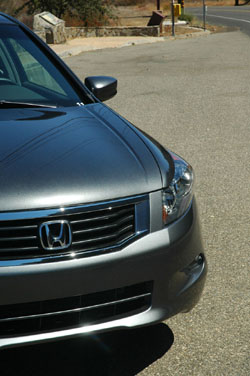 We'll start with the exterior. The Camry's latest redesign was purposeful enough that you could say it was actually styled. The Altima was done so well from the beginning that it drop-kicked the Maxima into some dark, quiet place. The Accord's new body was meant to give it some in-your-face-ness that would get the attention of the young professionals researching the segment and yet, as ever, wouldn't alienate the Accord lover. It has already received a noteworthy share of kudos and knocks, which is what happens any time a design attempts to make a statement. "Camber" was the word of the day, in reference to how the front of the car is drawn back at the headlights and the rear corners of the car gently slope into the valance. Along with the can't-be-missed side cut line and lower door line, there are quite a few instances of very subtly shaped bodywork: the merest hint of lines around the lower front fog lights and on the rear bumpers. Even the side mirror cover curves, seahorse-like, from a gently rounded top to the sculptured flick of a tail near the bottom, then curves again around the lower portion to the trim. In the flesh it's a good looking car, with silver and black suiting it exceptionally well in our opinion. It will more than hold its own with its competitors.
We'll start with the exterior. The Camry's latest redesign was purposeful enough that you could say it was actually styled. The Altima was done so well from the beginning that it drop-kicked the Maxima into some dark, quiet place. The Accord's new body was meant to give it some in-your-face-ness that would get the attention of the young professionals researching the segment and yet, as ever, wouldn't alienate the Accord lover. It has already received a noteworthy share of kudos and knocks, which is what happens any time a design attempts to make a statement. "Camber" was the word of the day, in reference to how the front of the car is drawn back at the headlights and the rear corners of the car gently slope into the valance. Along with the can't-be-missed side cut line and lower door line, there are quite a few instances of very subtly shaped bodywork: the merest hint of lines around the lower front fog lights and on the rear bumpers. Even the side mirror cover curves, seahorse-like, from a gently rounded top to the sculptured flick of a tail near the bottom, then curves again around the lower portion to the trim. In the flesh it's a good looking car, with silver and black suiting it exceptionally well in our opinion. It will more than hold its own with its competitors.
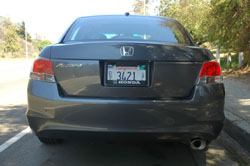 Inside? While all of the dimensions-interior and exterior-have grown, with the Accord's interior growth spurt by 3.3 cubic feet to 106, it's now classed as a large car by EPA standards. It was overall a fine place to be. The door panels flexed more than expected, and some cars had wider than usual gaps between the IP and the door, which could be explained by the fact that we were in a mix of production and pre-production vehicles.
Inside? While all of the dimensions-interior and exterior-have grown, with the Accord's interior growth spurt by 3.3 cubic feet to 106, it's now classed as a large car by EPA standards. It was overall a fine place to be. The door panels flexed more than expected, and some cars had wider than usual gaps between the IP and the door, which could be explained by the fact that we were in a mix of production and pre-production vehicles.
We didn't spend extended stretches in them, but the seats are plenty comfy and offer all the movements your body could want. Due to the added width, the center console can practically hide bodies. Lift the cover on the armrest and at the bottom of the abyss are a 12V outlet and an auxiliary (read: iPod) jack. Even the cupholders grew. In fact, they're immense. One of Honda's PR team said she sent Slurpee cups to Japan to prove to them that, yes, we really do need cavities that can hold firehouse buckets.
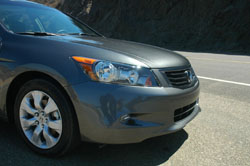 Forward, there's a contoured swath of textured plastic that caps the dashboard and console. The instrument panel lurks behind an enjoyably grippable steering wheel. Everything, though, flows to the center, which is where you'll find mission control. If you don't order the navigation, a 2-color screen sits atop the center stack. It was clear and legible in nearly all lighting conditions, save for when the coastal sun shone directly on it. If you splurge for the navigation, you get a much larger screen with a color display. On that, I wish the dashboard curved outward a bit more, to keep out more glare from the sun.
Forward, there's a contoured swath of textured plastic that caps the dashboard and console. The instrument panel lurks behind an enjoyably grippable steering wheel. Everything, though, flows to the center, which is where you'll find mission control. If you don't order the navigation, a 2-color screen sits atop the center stack. It was clear and legible in nearly all lighting conditions, save for when the coastal sun shone directly on it. If you splurge for the navigation, you get a much larger screen with a color display. On that, I wish the dashboard curved outward a bit more, to keep out more glare from the sun.
Below that is knob-and-button central. It's laid out well enough, but with the buttons stretched and pulled and curved to fit the console, I found it a bit Dali-esque. However, it's solid and the buttons feel good. The first time in the car I found almost every button with just a glance. The navigation, controlled by a multi-function knob, took a second to figure out, but it won't have you reaching for the manual. Besides, the control functions are written on the dash-it doesn't get any easier.
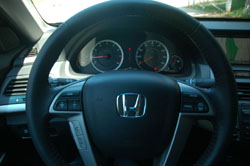 Below that is a cubby and two little doors: one covers 12V outlet that would have been a lighter in a previous life, the other covers a hole beside which is written "This is not an ashtray." All right then.
Below that is a cubby and two little doors: one covers 12V outlet that would have been a lighter in a previous life, the other covers a hole beside which is written "This is not an ashtray." All right then.
Let's get to the kicker: how do they drive? Well. There are four engine choices depending on which Accord model you choose: two inline 4-cylinders, both 2.4-liter VTECs, one with 177 hp and 161 ft-lb, another with 190 hp and 162 ft-lb; and two V6's, a 3.5-liter with 268 hp and 248 ft-lb, one of which features Honda's Variable Cylinder Management, and one that doesn't. All of the choices are ULEV-2 and/or PZEV rated. The 4-pot mpg comes in at 21 city, 31 hwy for both versions. The 6 cylinder auto gets 19/29, and the manual-in the coupe-gets 17/25.
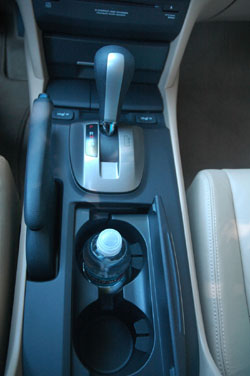 Speaking of gas mileage, the V6 with VCM (on the auto transmission) works in three modes: 3, 4, or all 6 cylinders. The previous generation only had two modes, 3-cylinder and 6. It also comes with an ECO light that illuminates in the tachometer when you're getting 22.5 mpg or better.
Speaking of gas mileage, the V6 with VCM (on the auto transmission) works in three modes: 3, 4, or all 6 cylinders. The previous generation only had two modes, 3-cylinder and 6. It also comes with an ECO light that illuminates in the tachometer when you're getting 22.5 mpg or better.
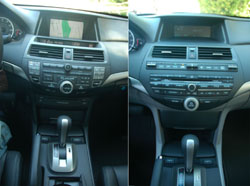 We only drove the 4-cylinder automatic, not the manual. It's quiet, and while it will get the job done, it will do so at a leisurely pace. You can push it, but the extra giddyup won't be worth the effort and revs that come with it except in the most compelling circumstances. This is your sipper, not your slayer, so enjoy it as such. The V6 is a much heartier workhorse. Standing starts, passing maneuvers, climbing, all happen with the competence of a trusted assistant: not quite fast enough to spill anything, but you know the job is getting done right, right now.
We only drove the 4-cylinder automatic, not the manual. It's quiet, and while it will get the job done, it will do so at a leisurely pace. You can push it, but the extra giddyup won't be worth the effort and revs that come with it except in the most compelling circumstances. This is your sipper, not your slayer, so enjoy it as such. The V6 is a much heartier workhorse. Standing starts, passing maneuvers, climbing, all happen with the competence of a trusted assistant: not quite fast enough to spill anything, but you know the job is getting done right, right now.
The ride is just right for the category. The sedans ride on either 16- or 17-inch wheels, the coupe gets 17- or 18-inch. The front suspension is a modified double wishbone from the previous model, and all but the base LX model get a front suspension tower brace. The rear is a new, compact multi-link with nitrogen-filled coil-over dampers. The result is potholes go barely noticed and poorly-surfaced roads don't rock the ride. A new engine mounting system reduces NVH and helps the body and engine move in greater unison, and the new variable gear steering translates inputs nicely. There's even a fair bit of sporty thrown in, with reassuring composure in turns taken at speed.
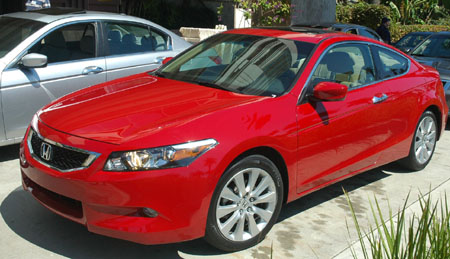
The coupe, however, is where the real action resides. The coupe isn't the sedan's sibling; it's more like the third cousin by marriage twice removed. The 6-speed manual mated to the 268 hp doesn't just transform the car, it transmogrifies it. From the first stoplight I understood why the gents who had the car before me took so long to bring it back. I think every stoplight after that had me setting off the ESC, a little yellow triangle flashing furiously as the front wheels did their best not to come unstuck. It has so much jump, in fact, that you need to hold on to the steering wheel quite firmly in order not to let the car torque steer into a regrettable sidestep.
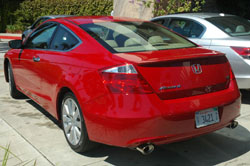 The coupe was like driving a sedate S2000, which, in light of the S2000's frantic nature, isn't at all a letdown. And it's got a more room. And a back seat. And a trunk that fits more than a ham sandwich. Gary said that they wanted to create a driving experience that still fit with the Accord family, but was truly fun. Mission certifiably accomplished.
The coupe was like driving a sedate S2000, which, in light of the S2000's frantic nature, isn't at all a letdown. And it's got a more room. And a back seat. And a trunk that fits more than a ham sandwich. Gary said that they wanted to create a driving experience that still fit with the Accord family, but was truly fun. Mission certifiably accomplished.
And though we asked, they didn't give us prices. The best we could get was a range of $20K to $30K. There is also no hybrid coming, but there is a diesel in the works. For now, I'll take a black on black coupe. And a spare set of front tires.


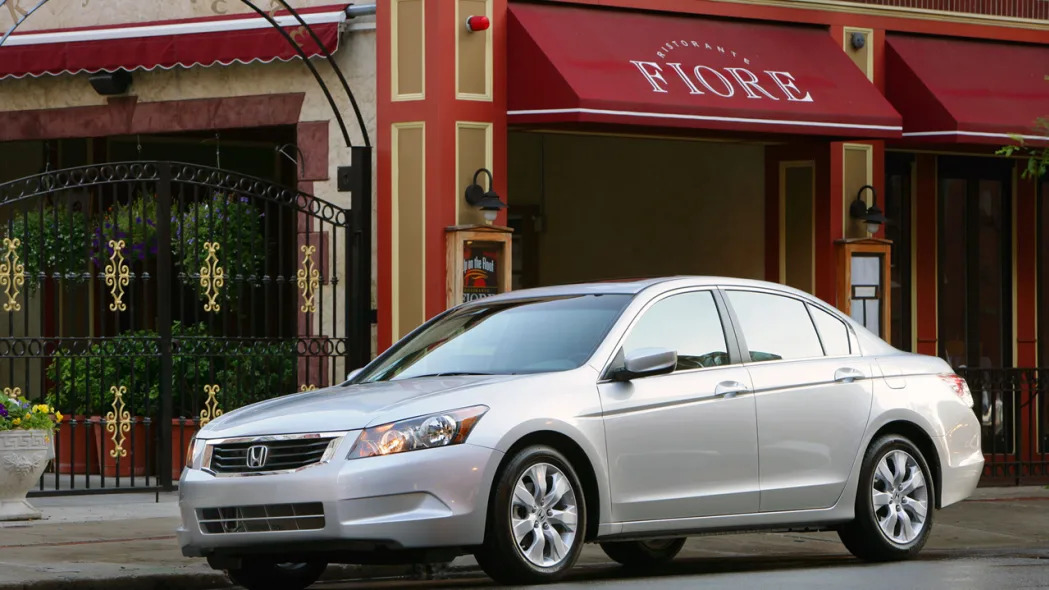


Sign in to post
Please sign in to leave a comment.
Continue